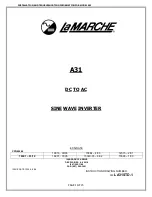
English
5. SYSTEM PARAMETERS
Parameter Function
Range
[Default]
Description / Notes
G85139-H1750-U049-C1
© Siemens plc 1999
19/08/99
38
P910
••••
Local/Remote mode
0 - 4
[0]
Sets the inverter for local control or remote control over the serial link:
0
= Local control
1
= Remote control (and setting of parameter values)
2
= Local control (but remote control of frequency)
3
= Remote control (but local control of frequency)
4
= Local control (but remote read and write access to
parameters and facility to reset trips)
Note:
When operating the inverter via remote control (P910 = 1
or 3), the analogue input remains active when P006 = 1
and is added to the setpoint.
P922
Software version
0.00 -
99.99
[-]
Contains the software version number and cannot be changed.
P923
••••
Equipment system number
0 - 255
[0]
You can use this parameter to allocate a unique reference number to
the inverter. It has no operational effect.
P930
Most recent fault code
0 - 9999
[-]
The last recorded fault code
(see section 6)
is stored in this parameter.
This parameter can be cleared using the
∆
and
∇
buttons.
P931
Most recent warning type
0 - 9999
[-]
The last recorded warning is stored in this parameter until power is
removed from the inverter:
002
= Current limit active
003
= Voltage limit active
005
= Inverter over-temperature (Internal PTC)
006
= Motor over-temperature
018
= Auto restart after fault
Warning:
inverter may start at any time!
P944
Reset to factory default settings
0 - 1
[0]
Set to ‘1’ and then press
P
to reset all parameters except P101 to the
factory default settings.
P971
••••
EEPROM storage control
0 - 1
[1]
0
= Changes to parameter settings (including P971) are lost when
power is removed.
1
= Changes to parameter settings are retained during periods
when power is removed.
WARNING: When using the serial link to update the parameter
set held in EEPROM, care must be taken not to
exceed the maximum number of write cycles to this
EEPROM - this is approximately 50,000 write cycles.
Exceeding this number of write cycles would result
in corruption of the stored data and subsequent
data loss. The number of read cycles are unlimited.











































